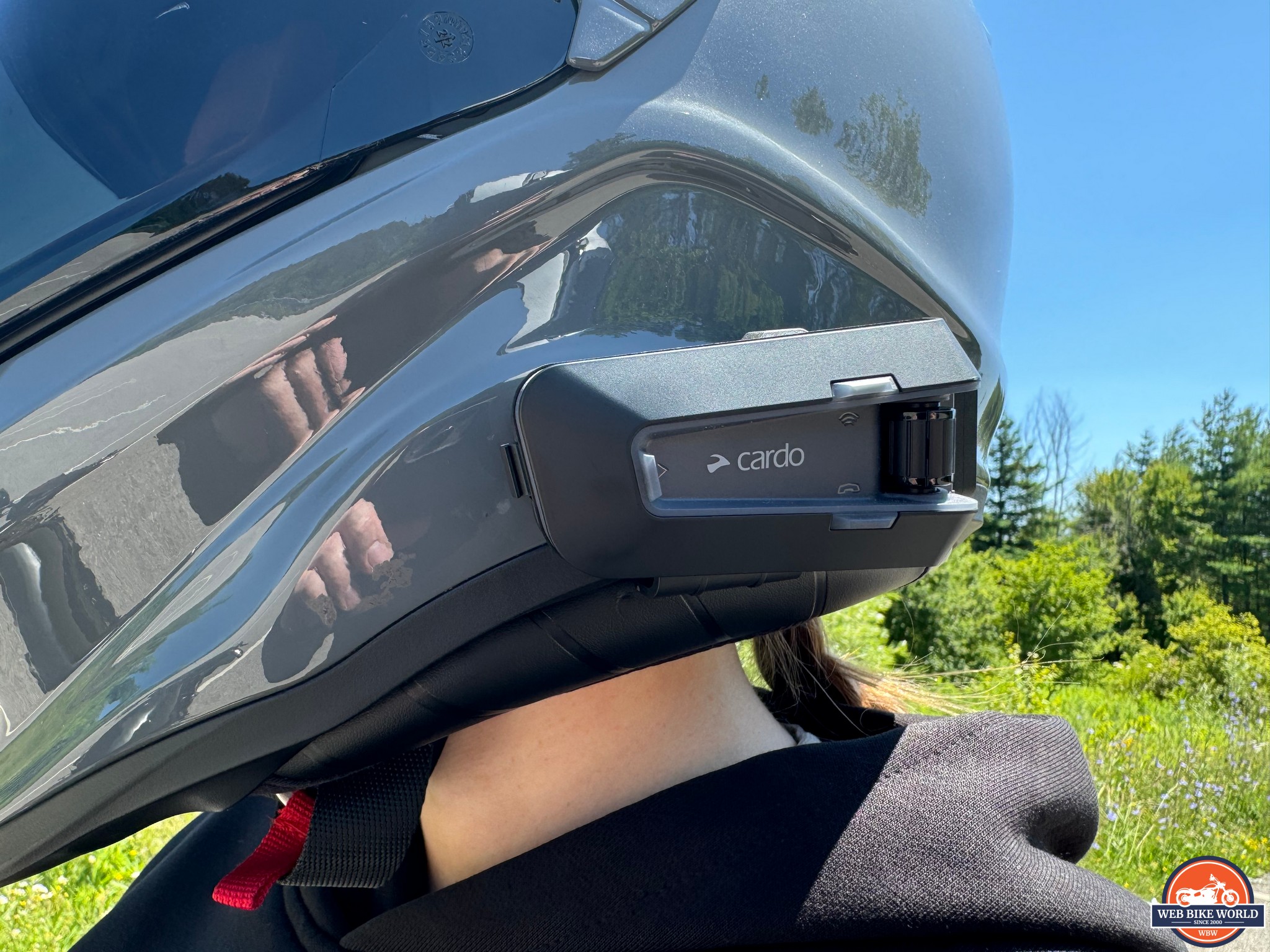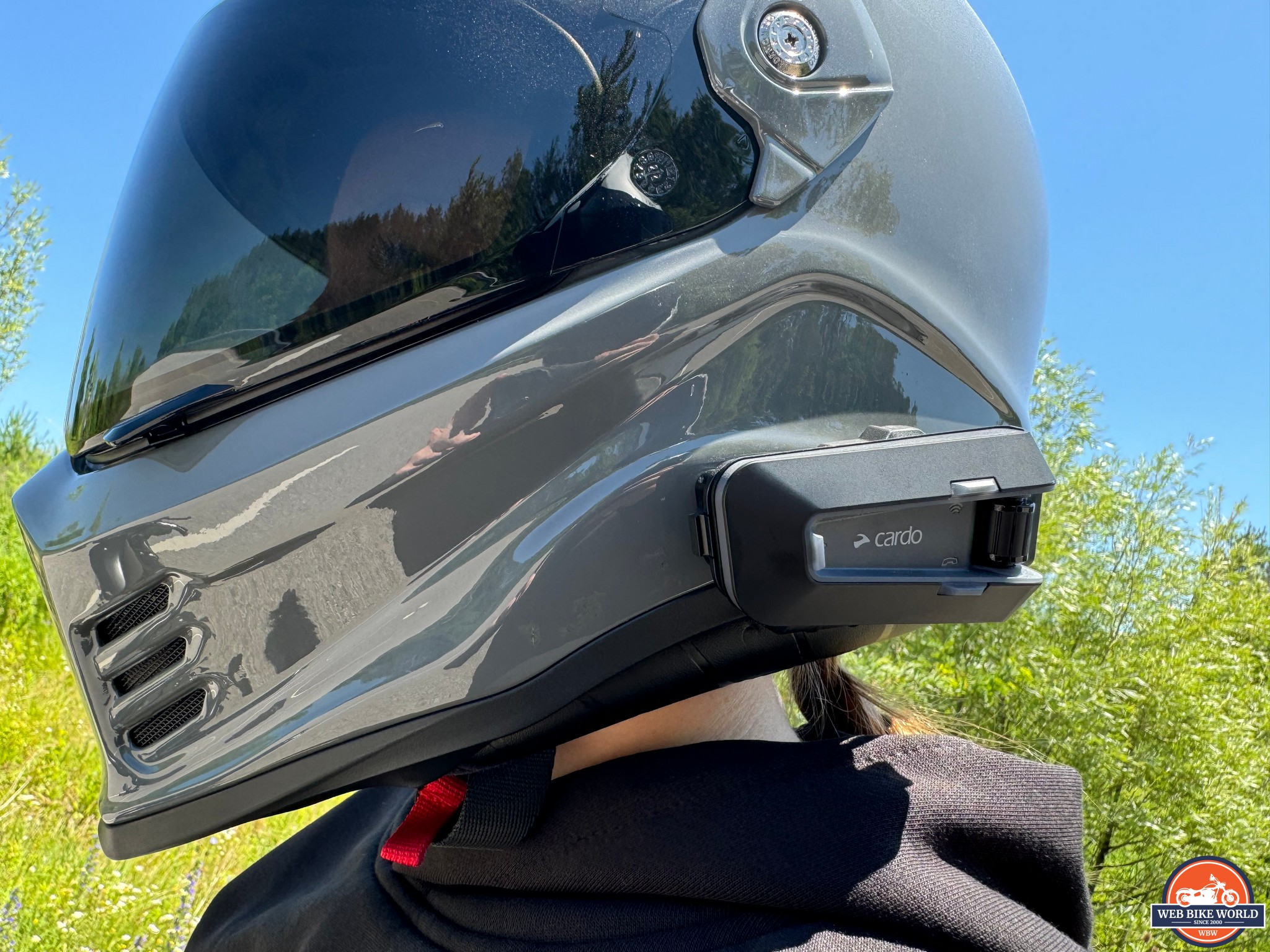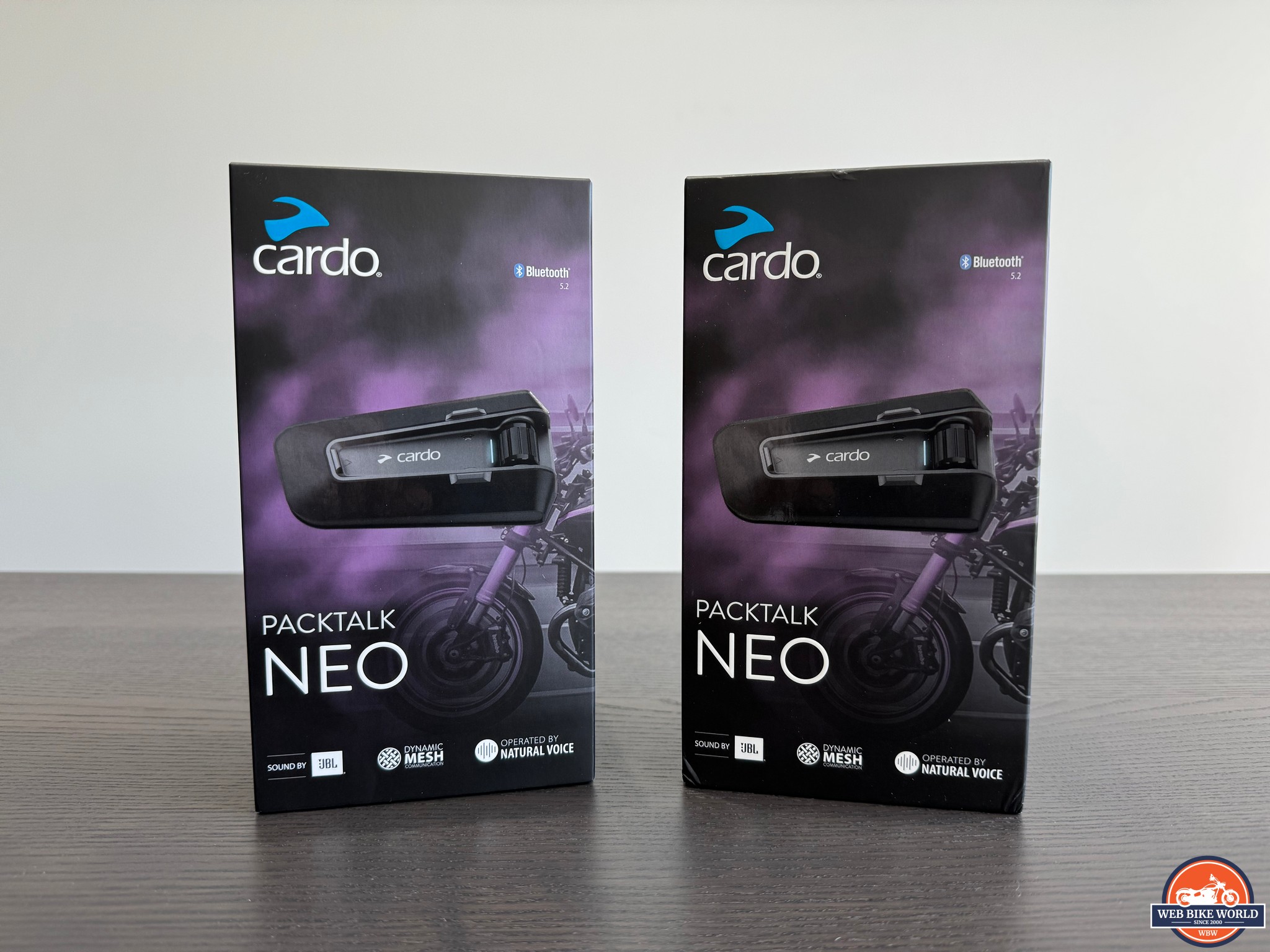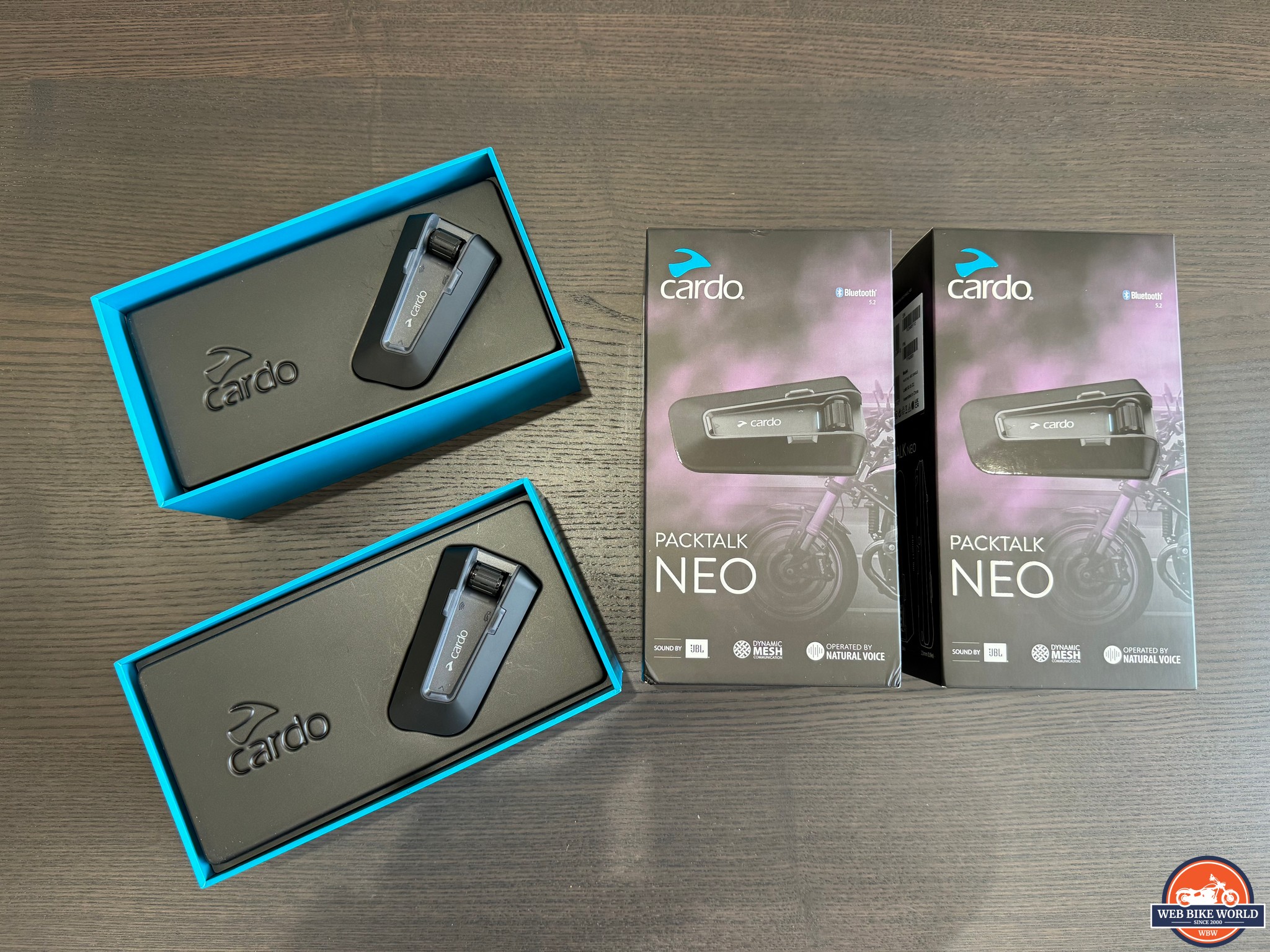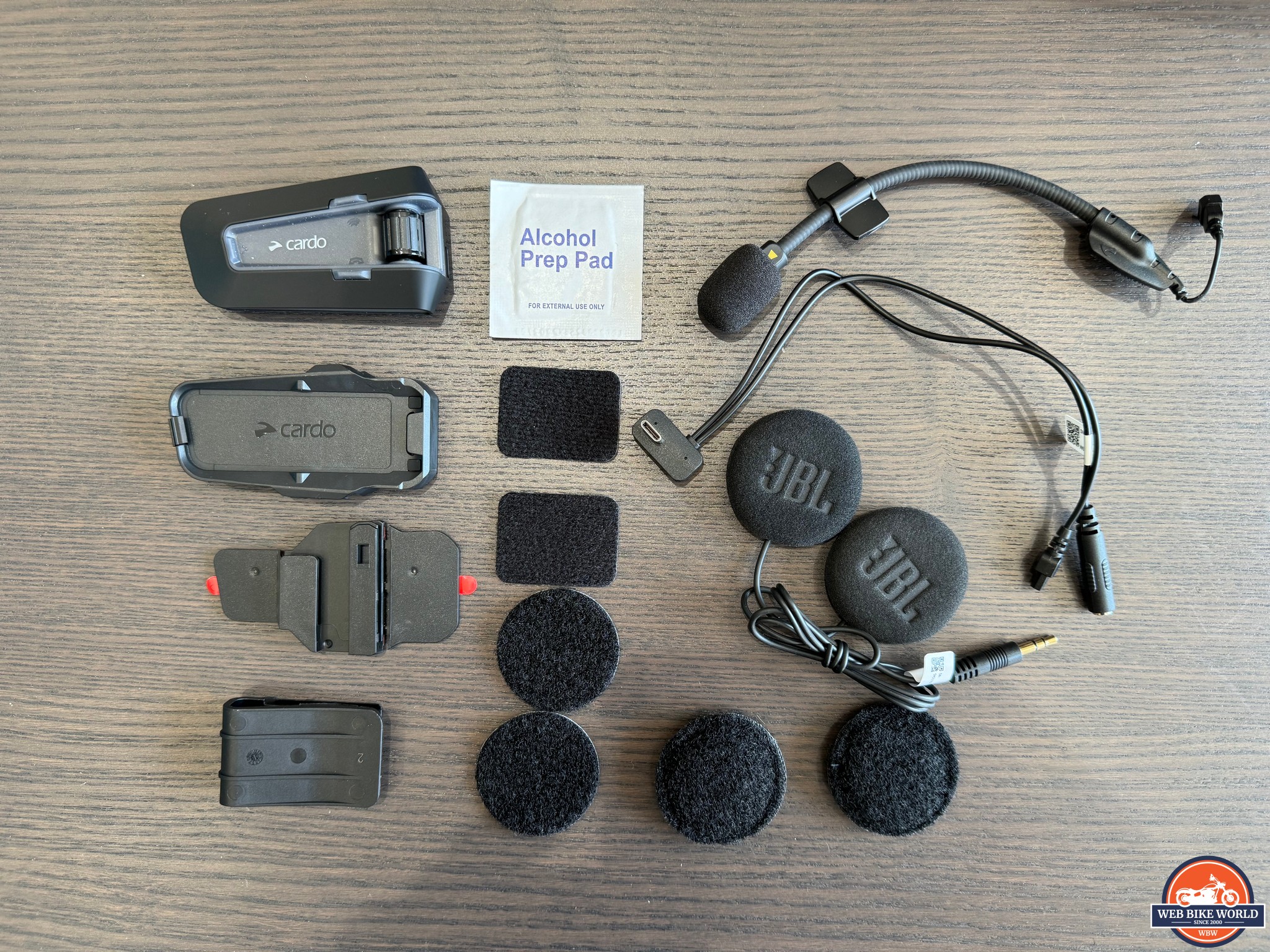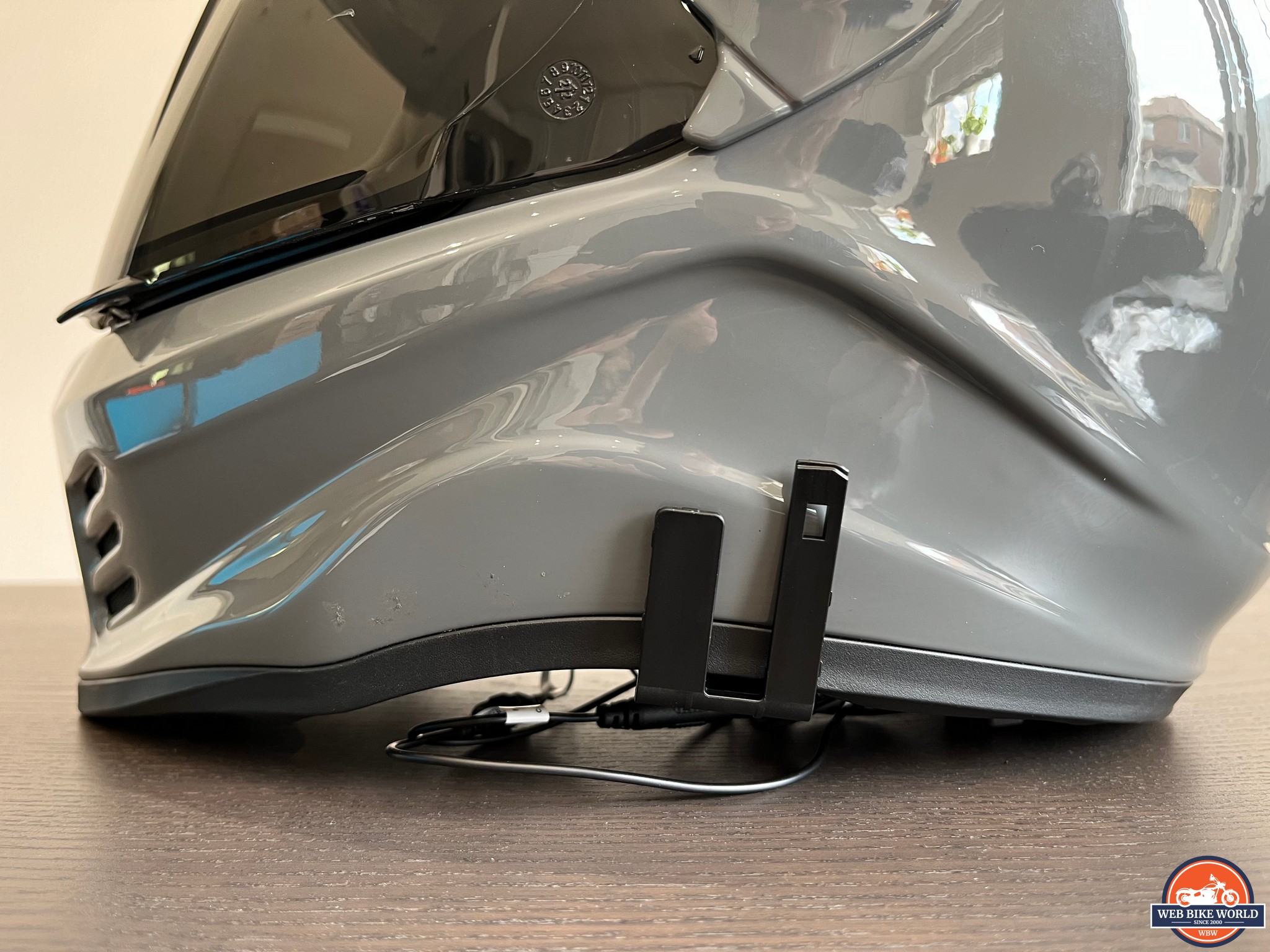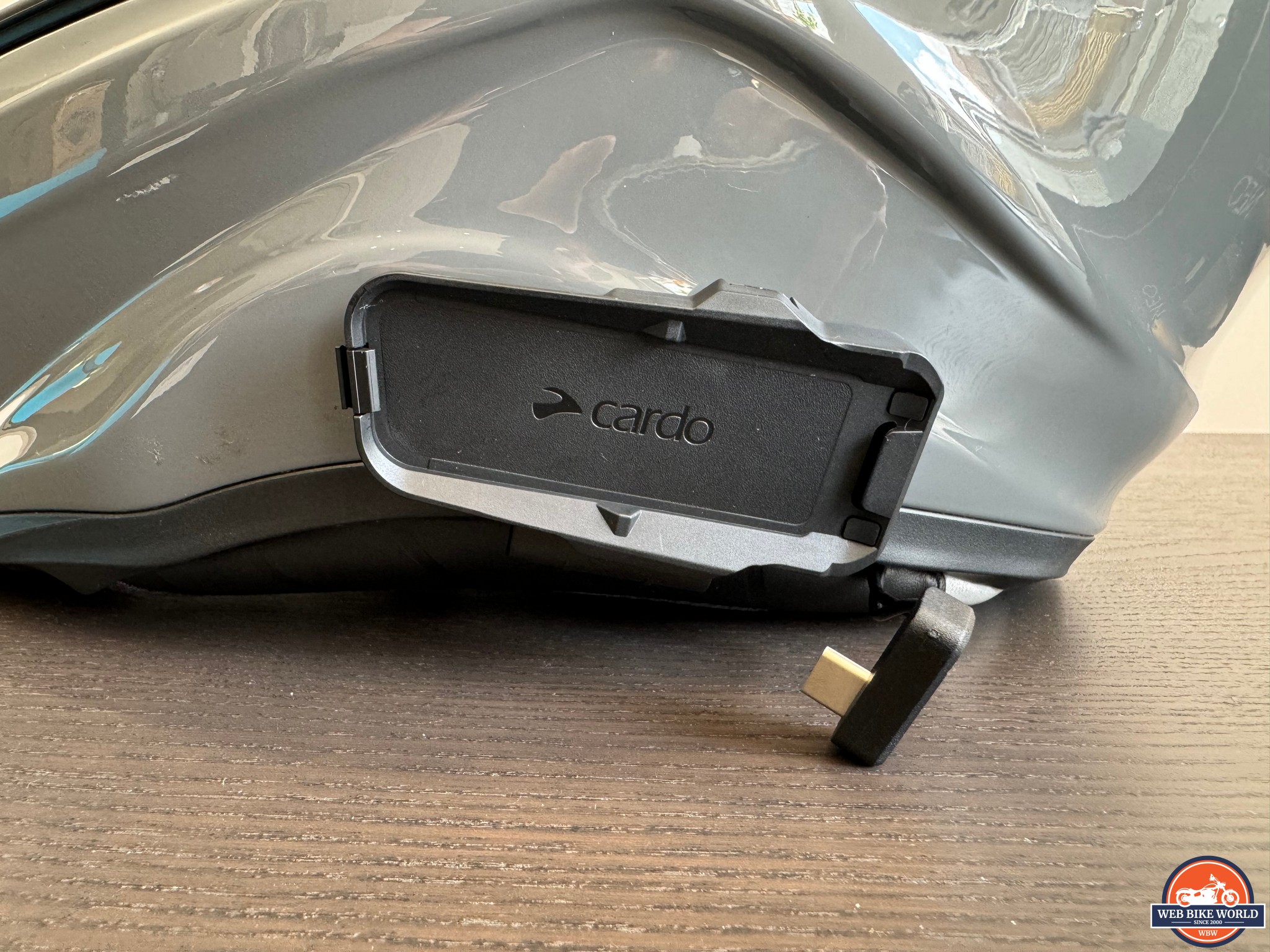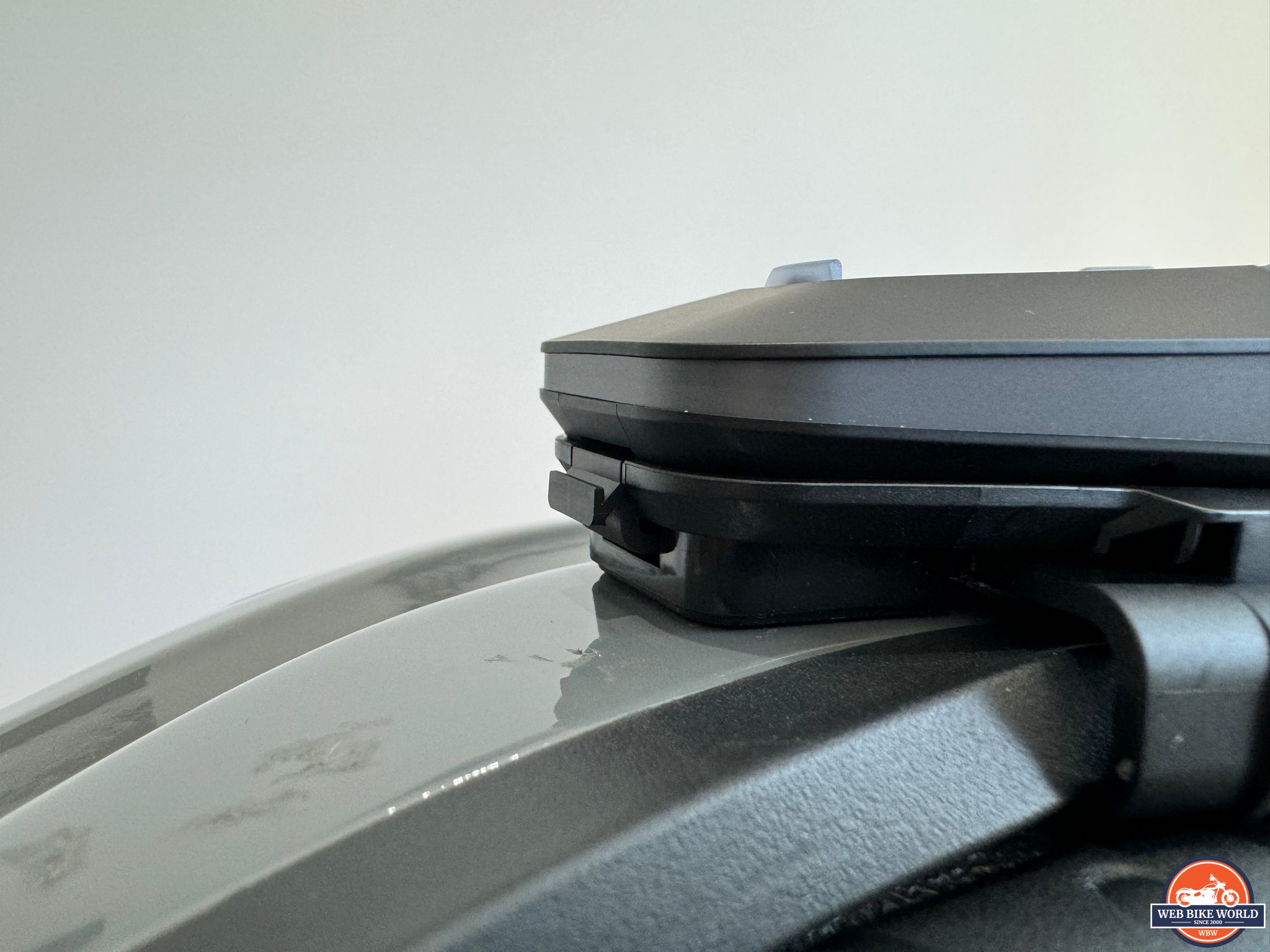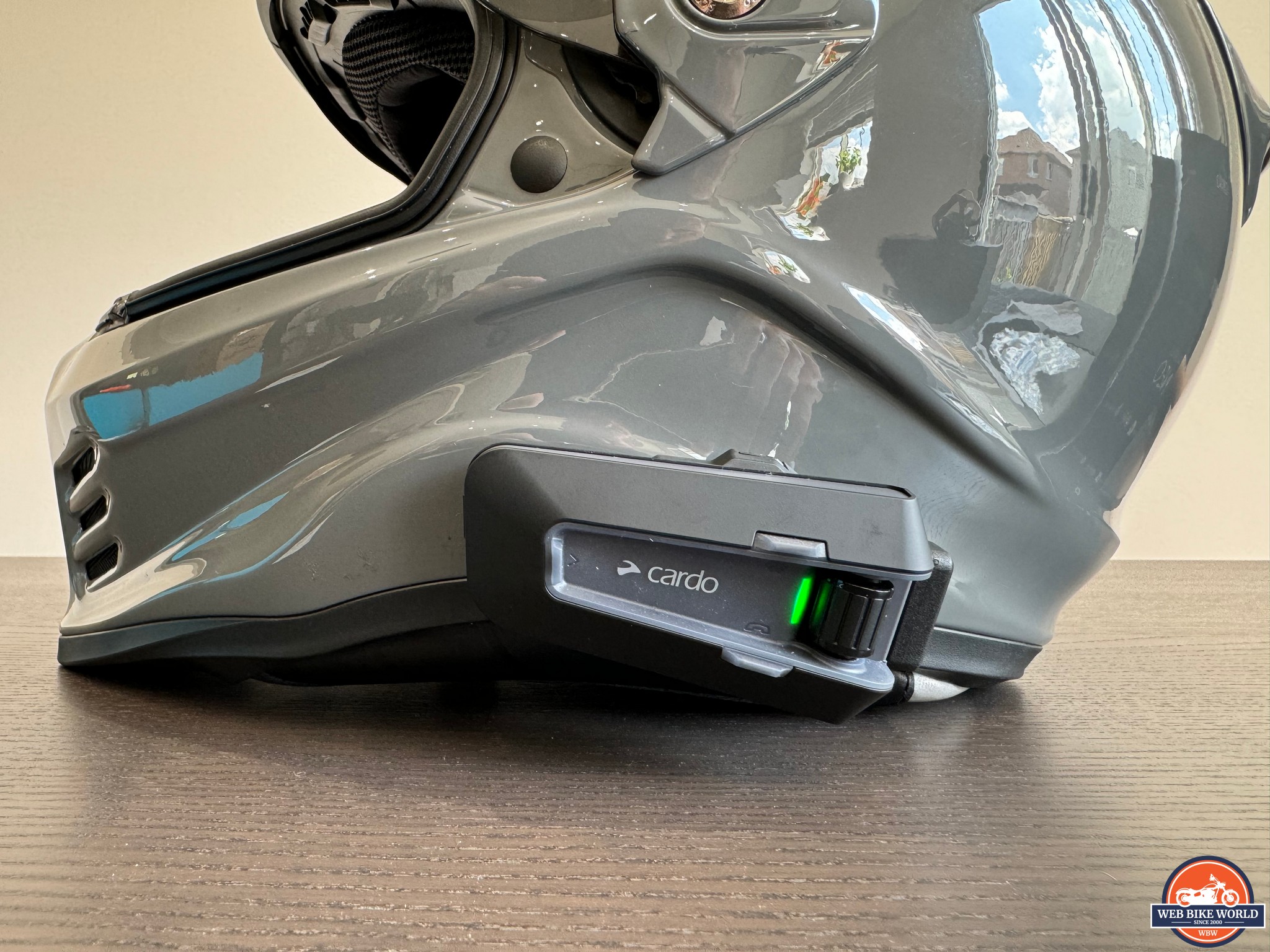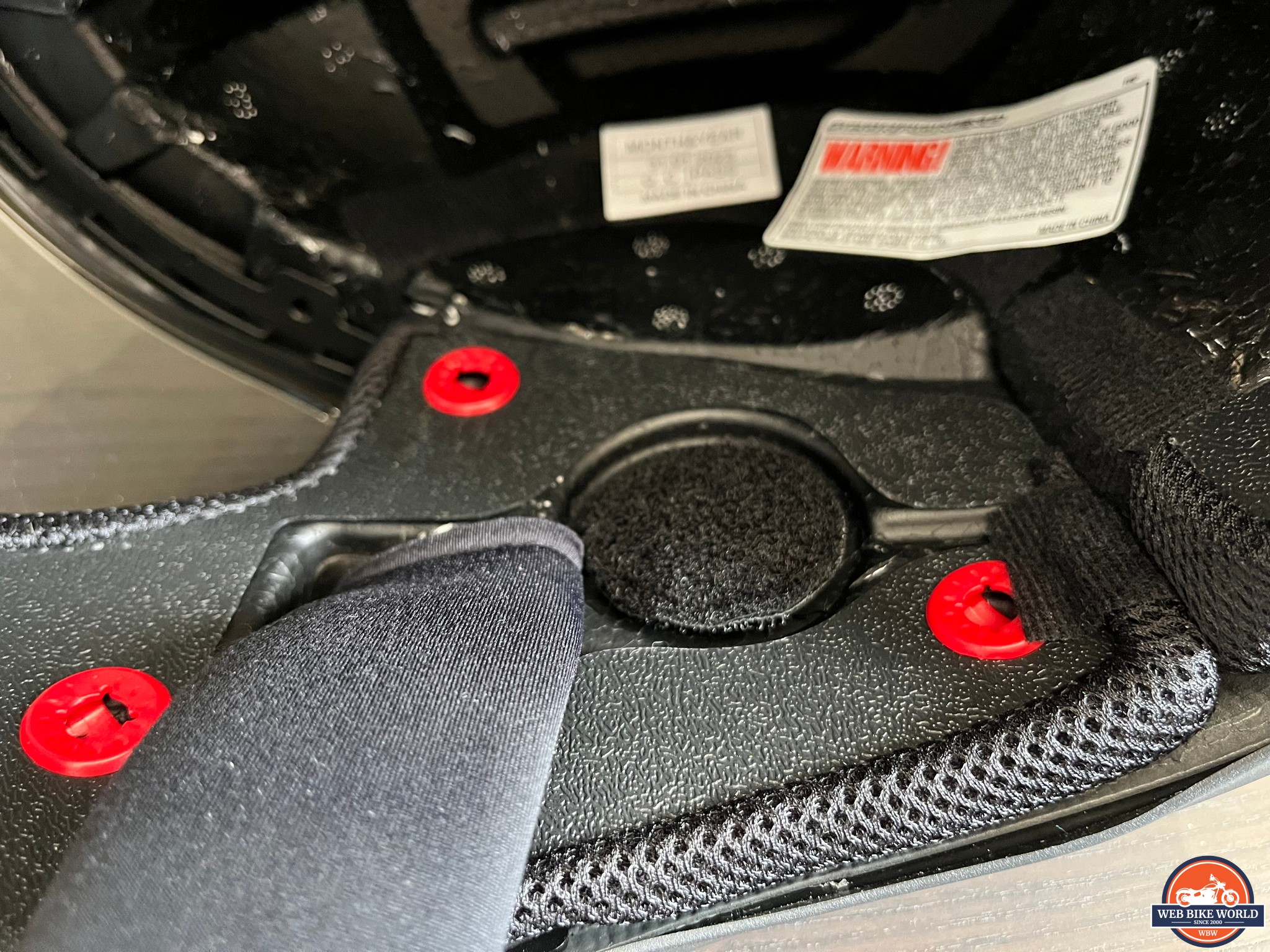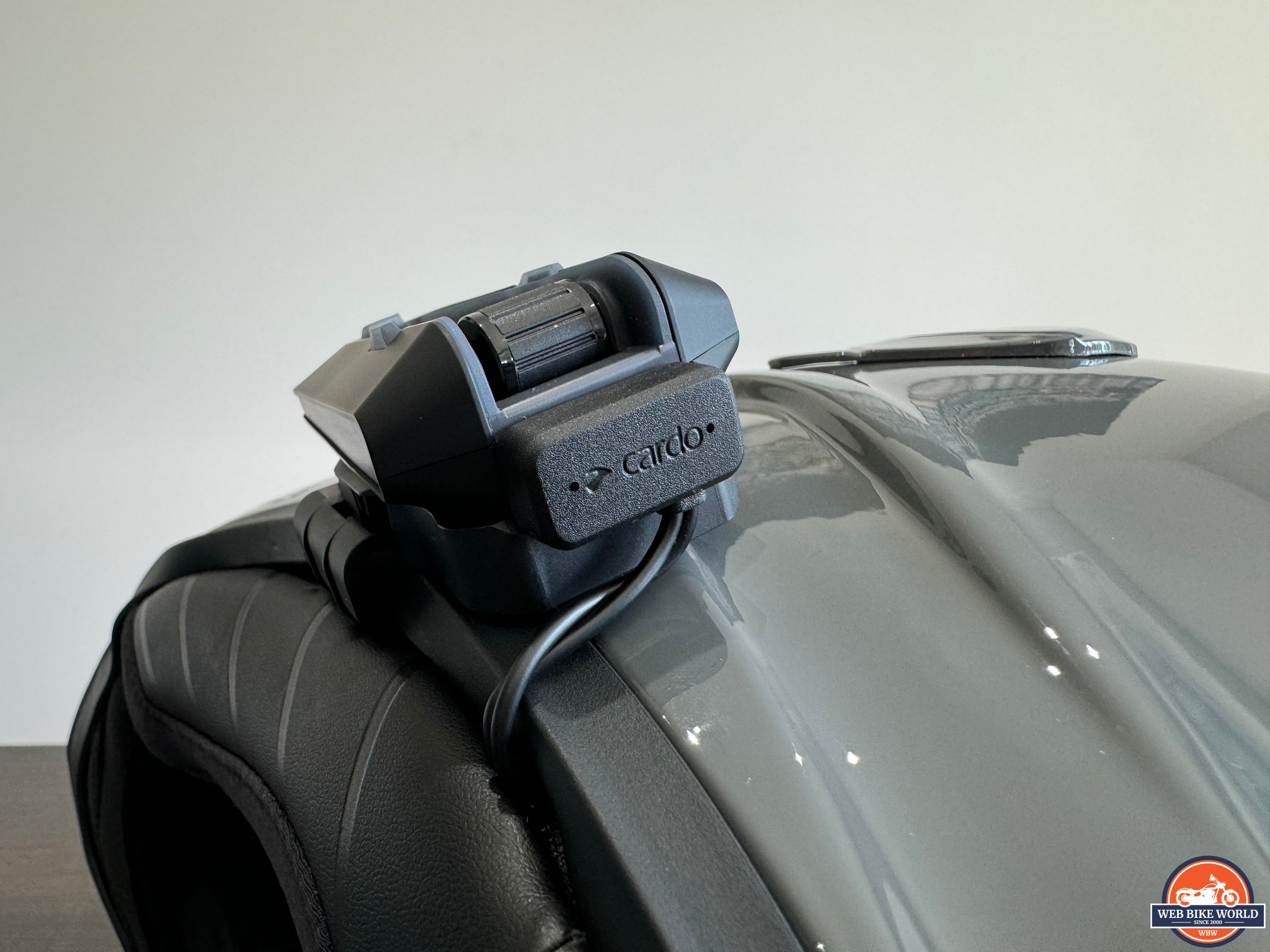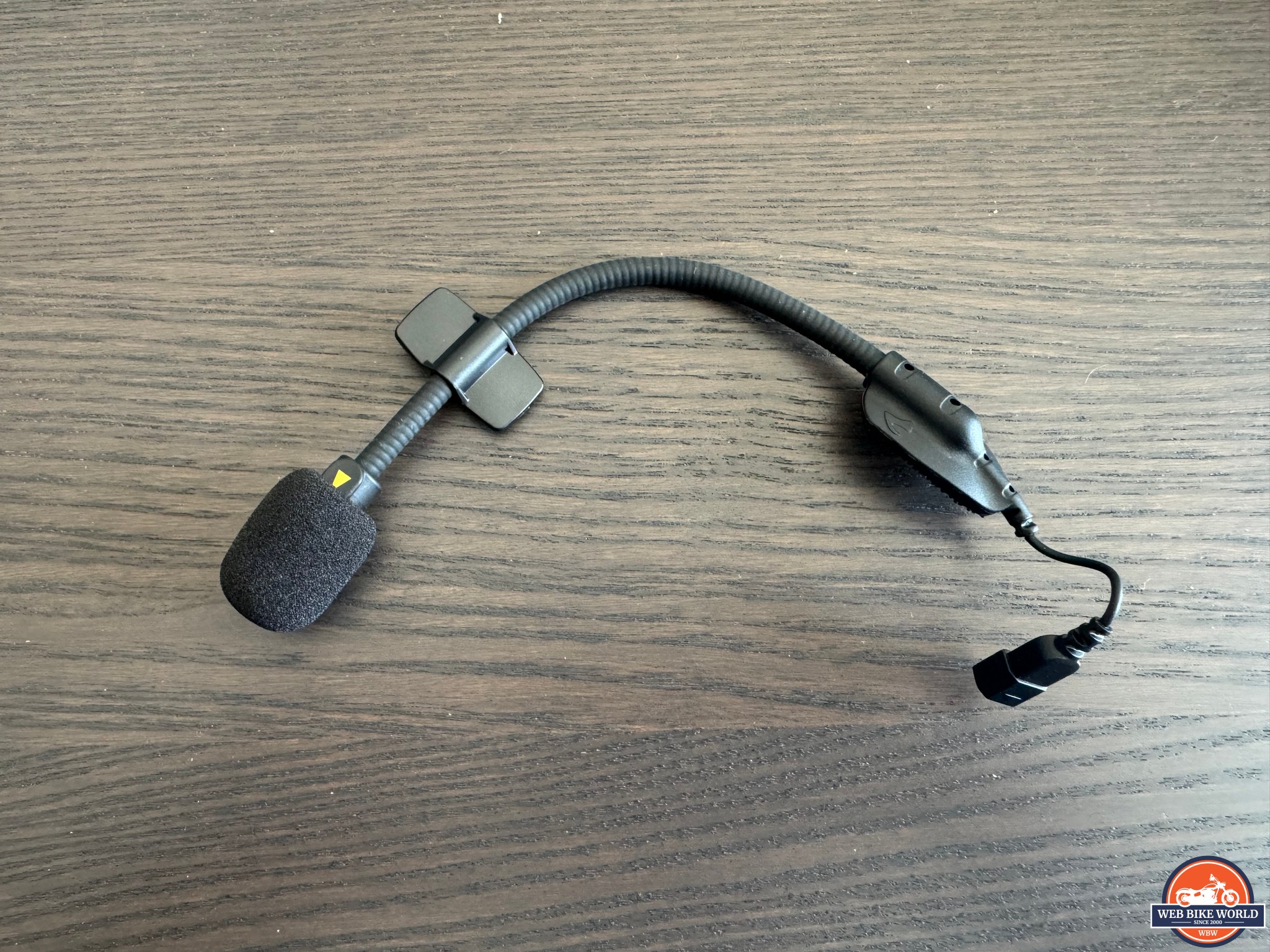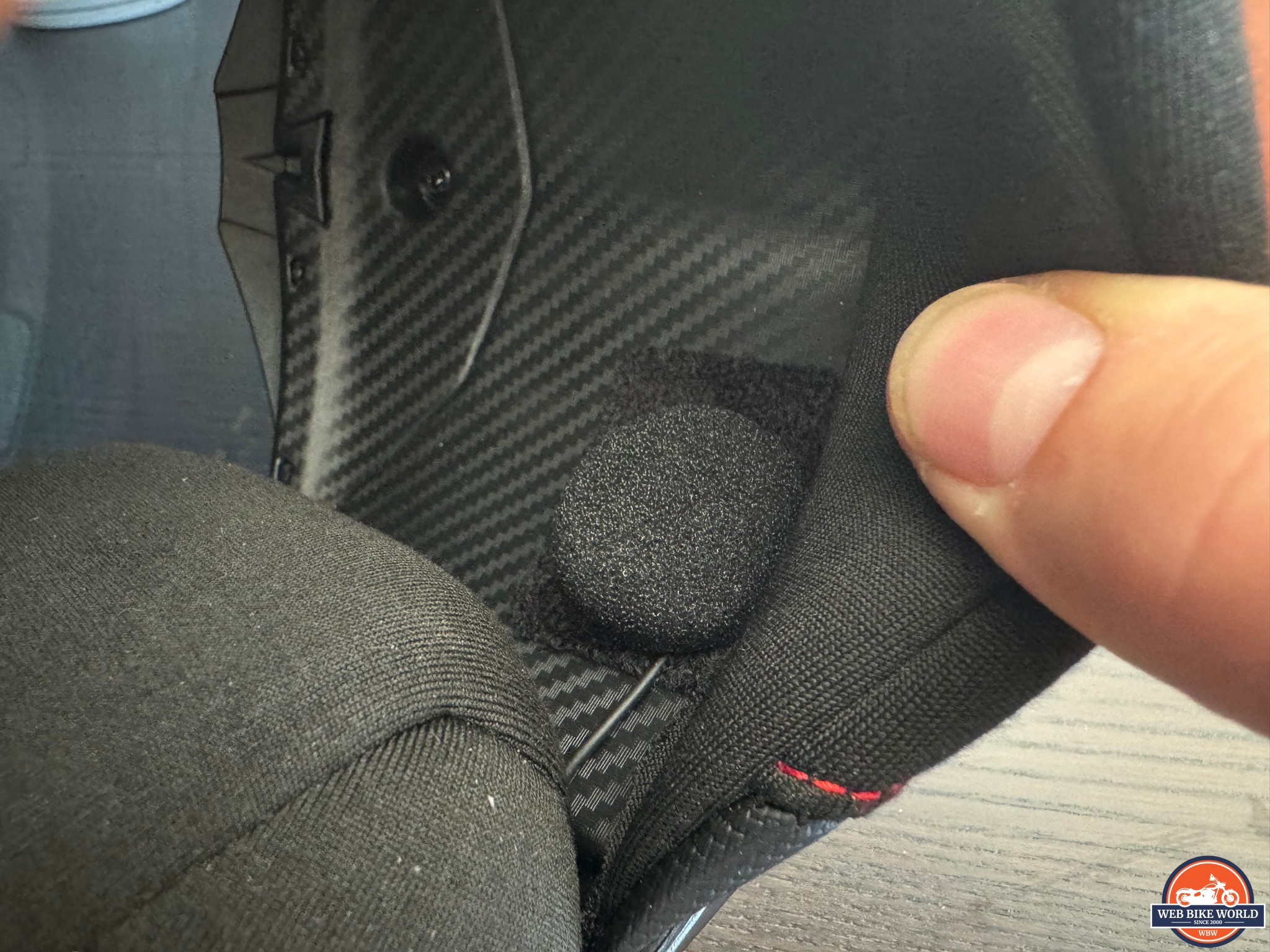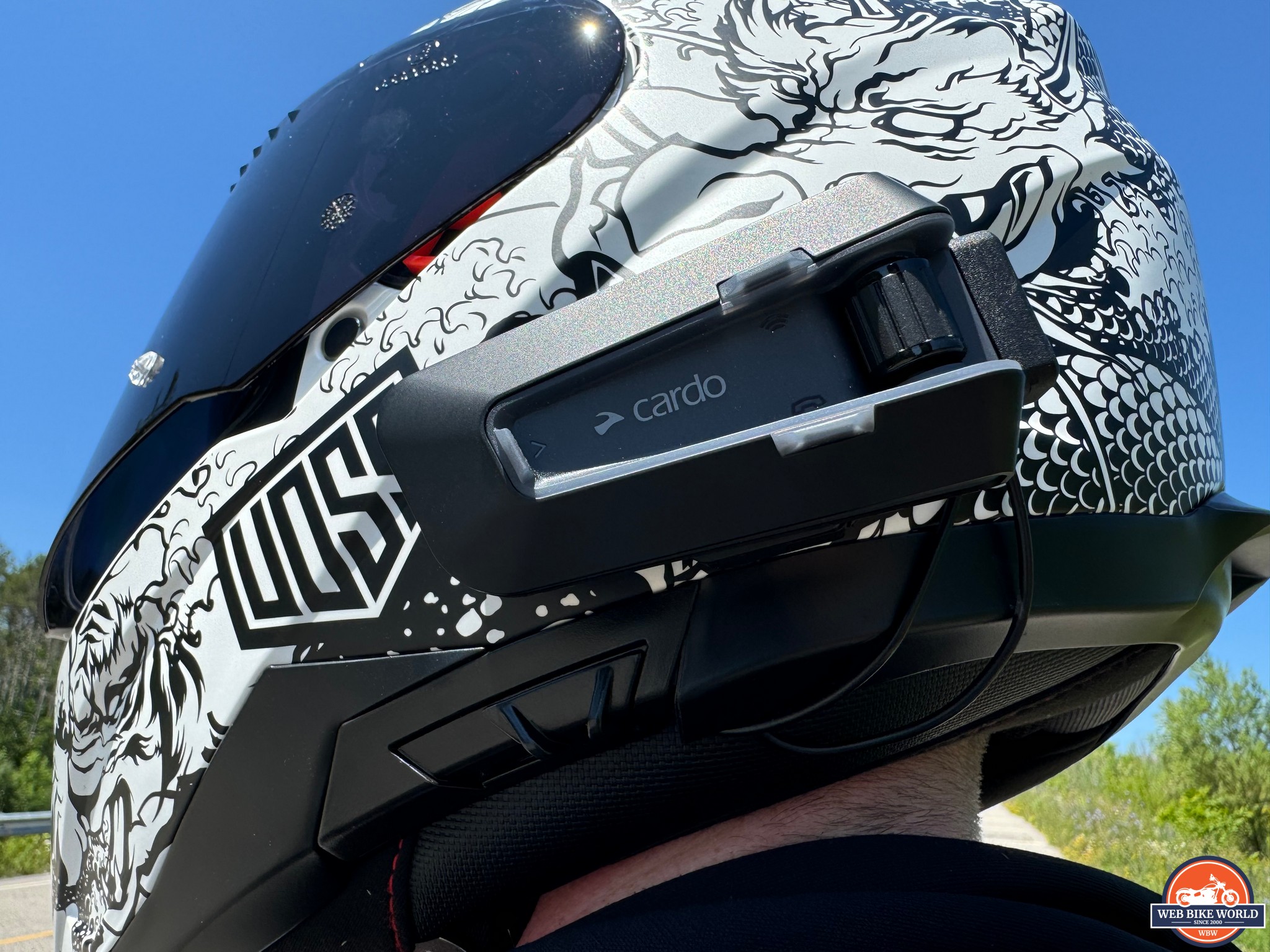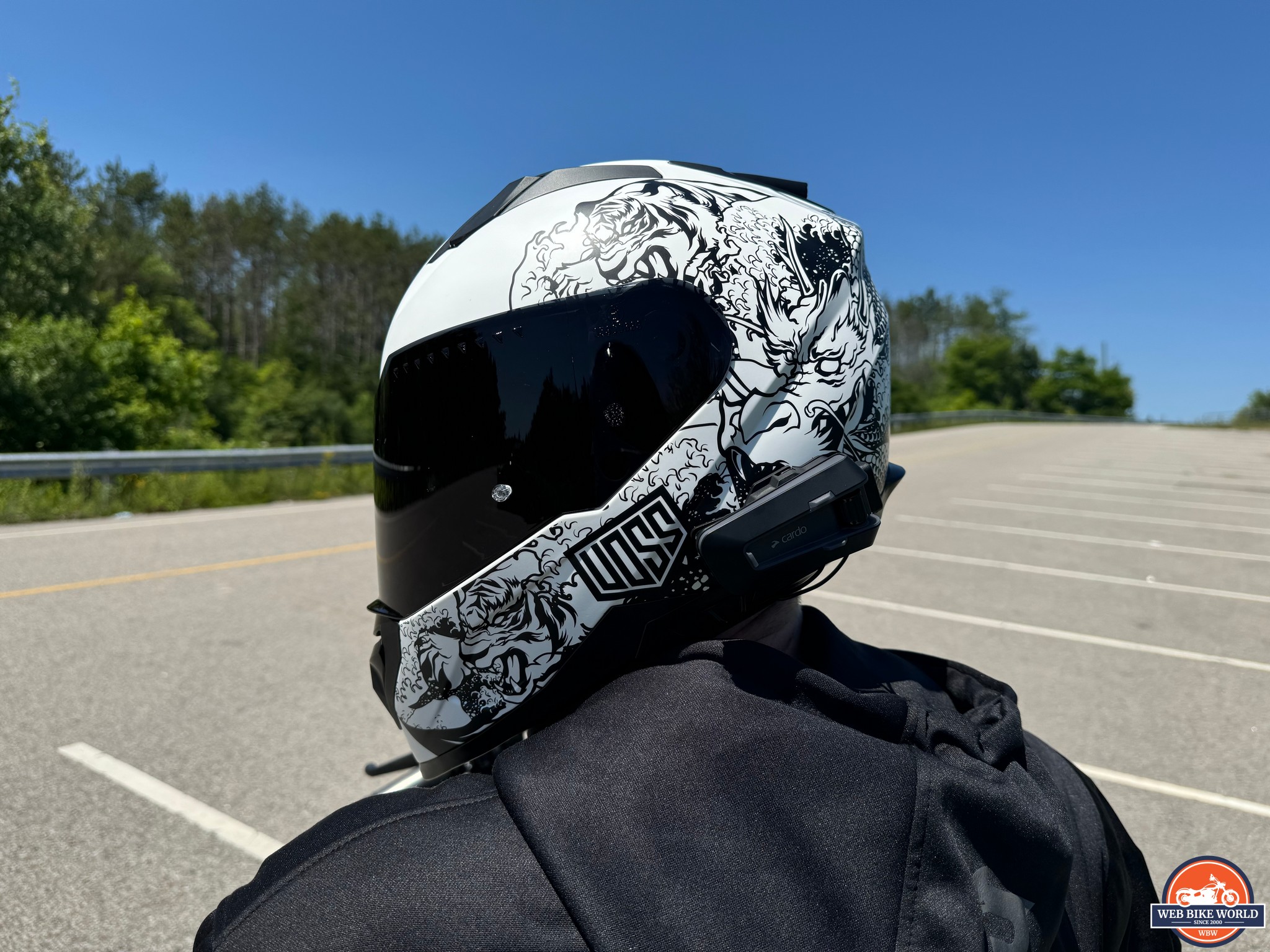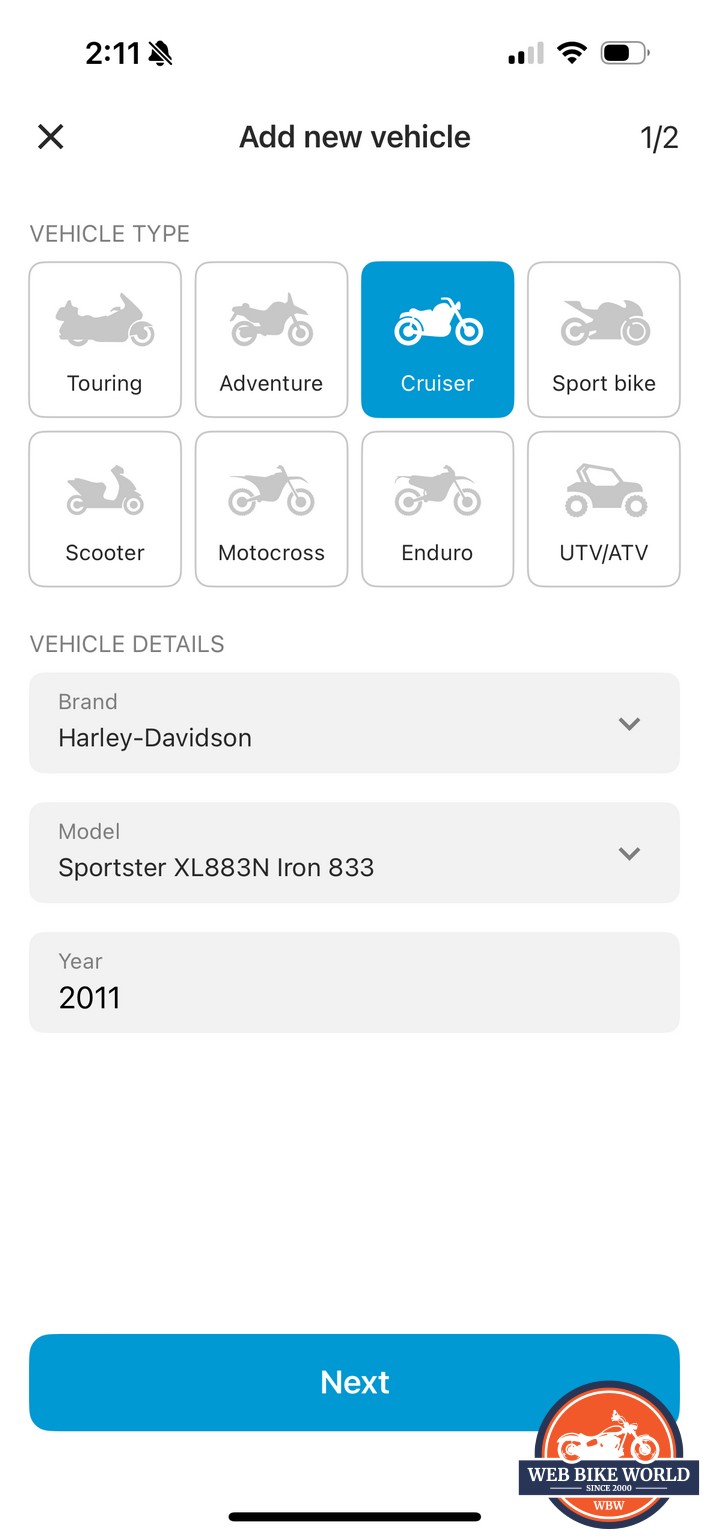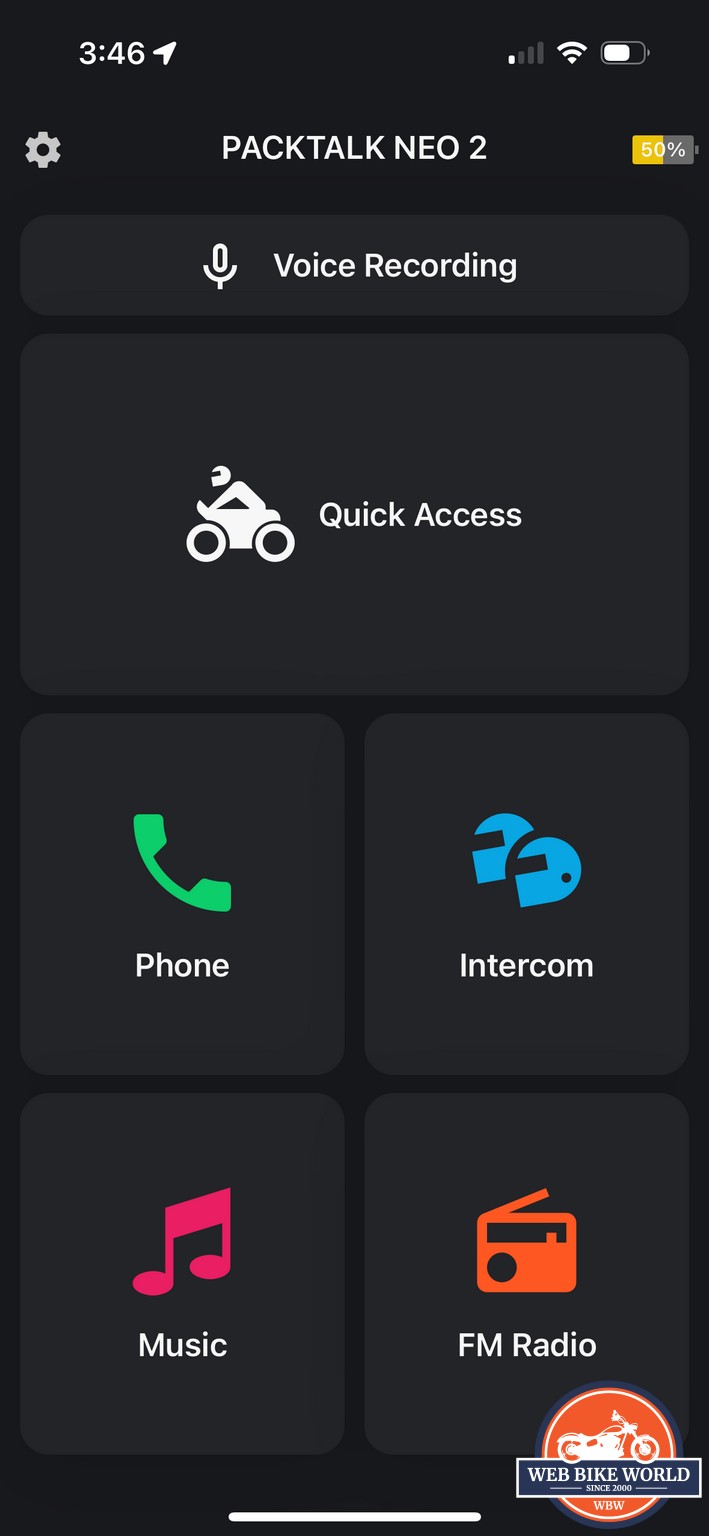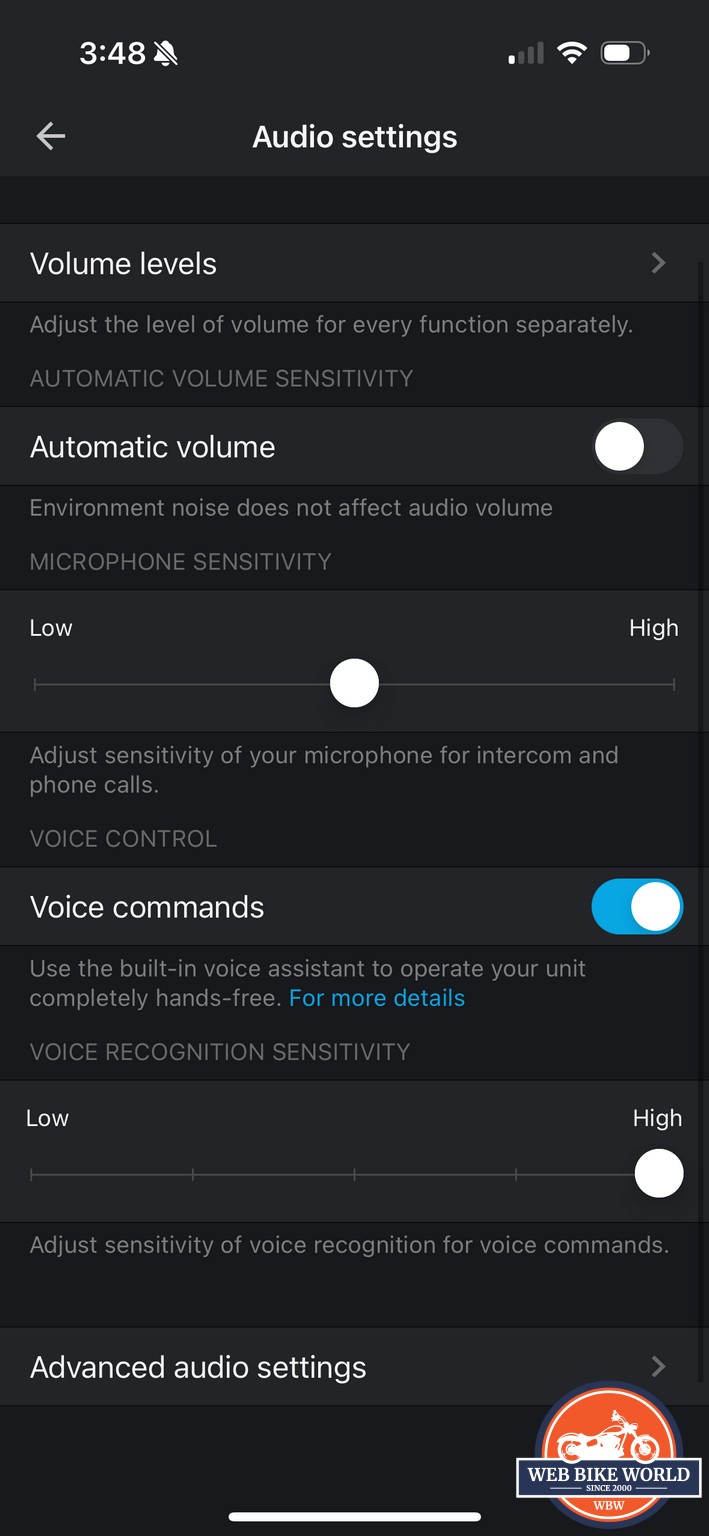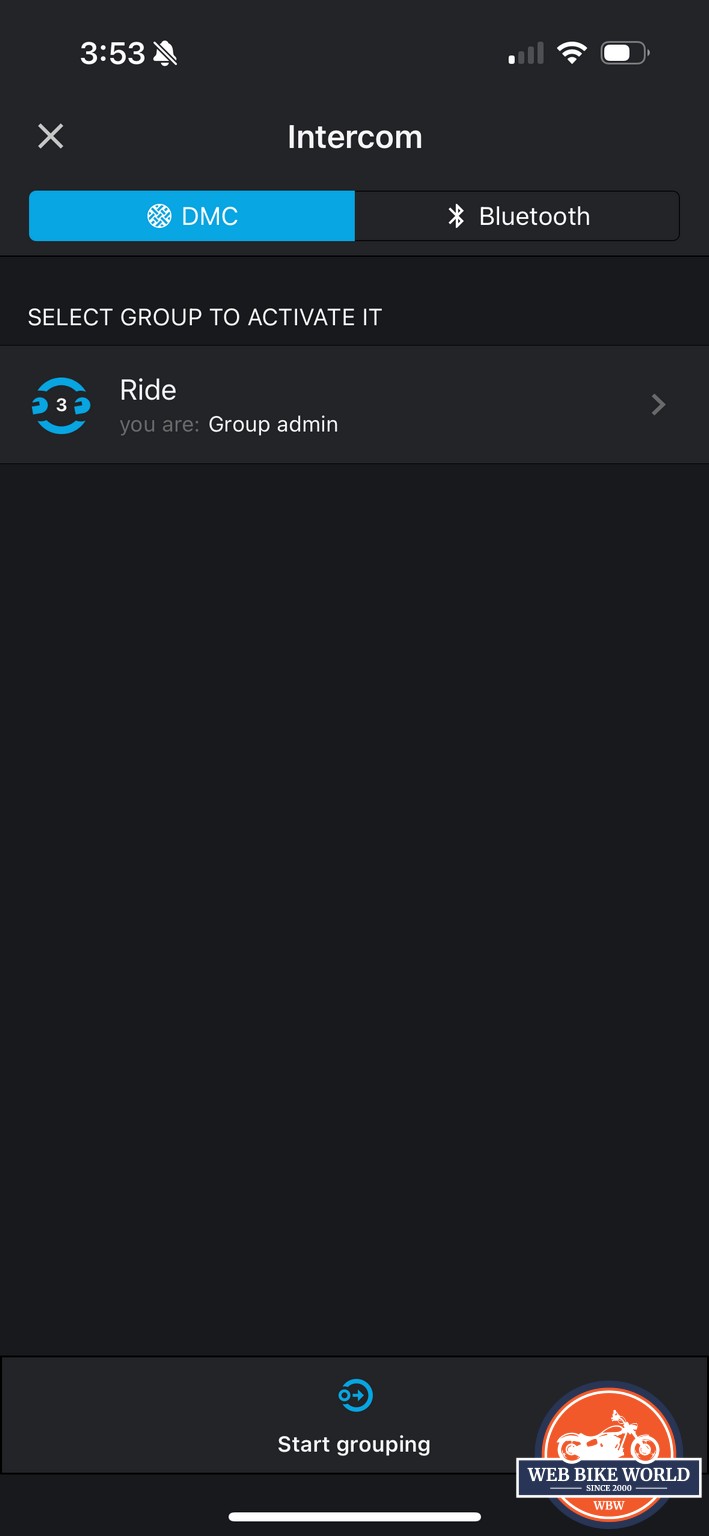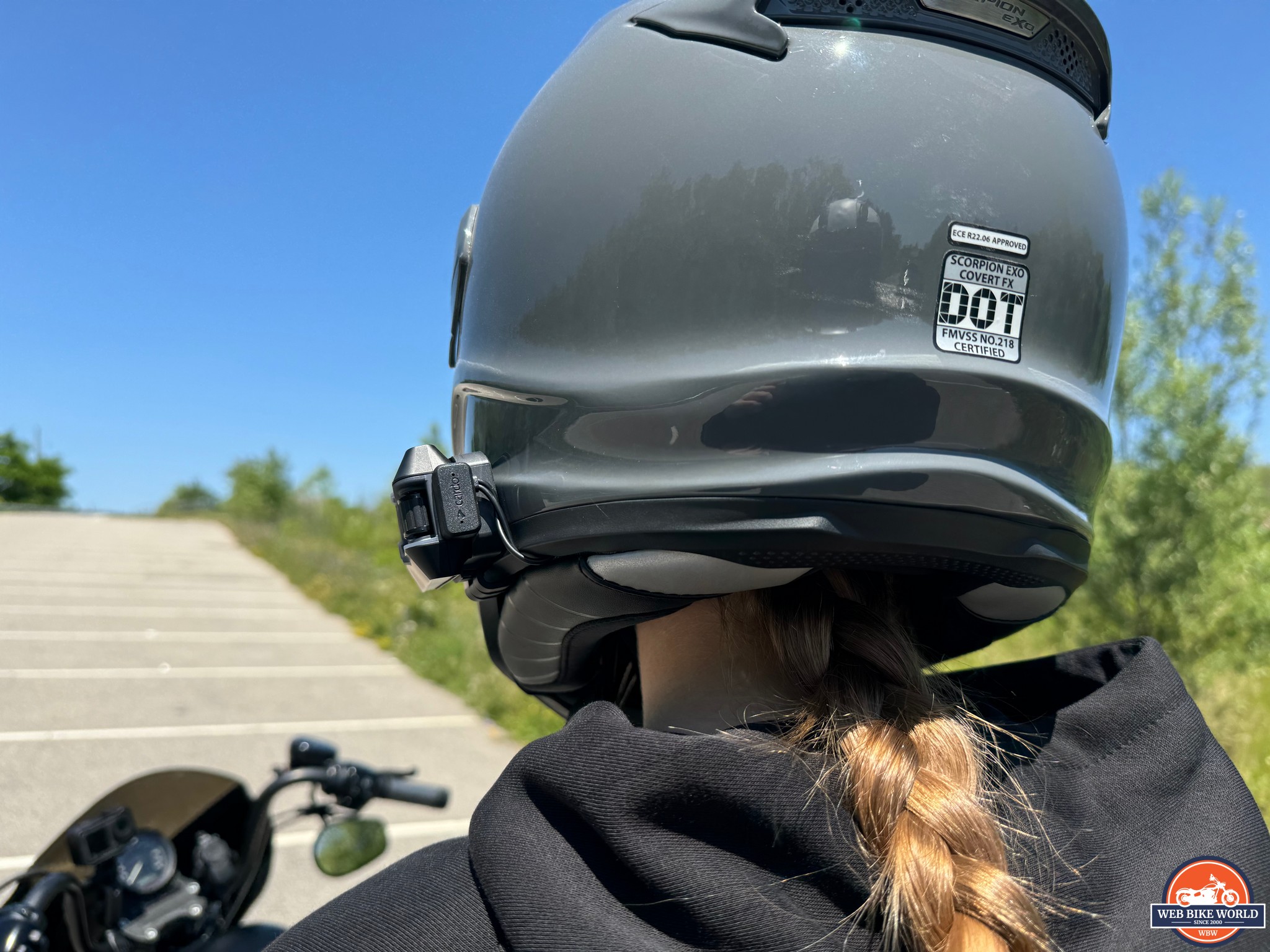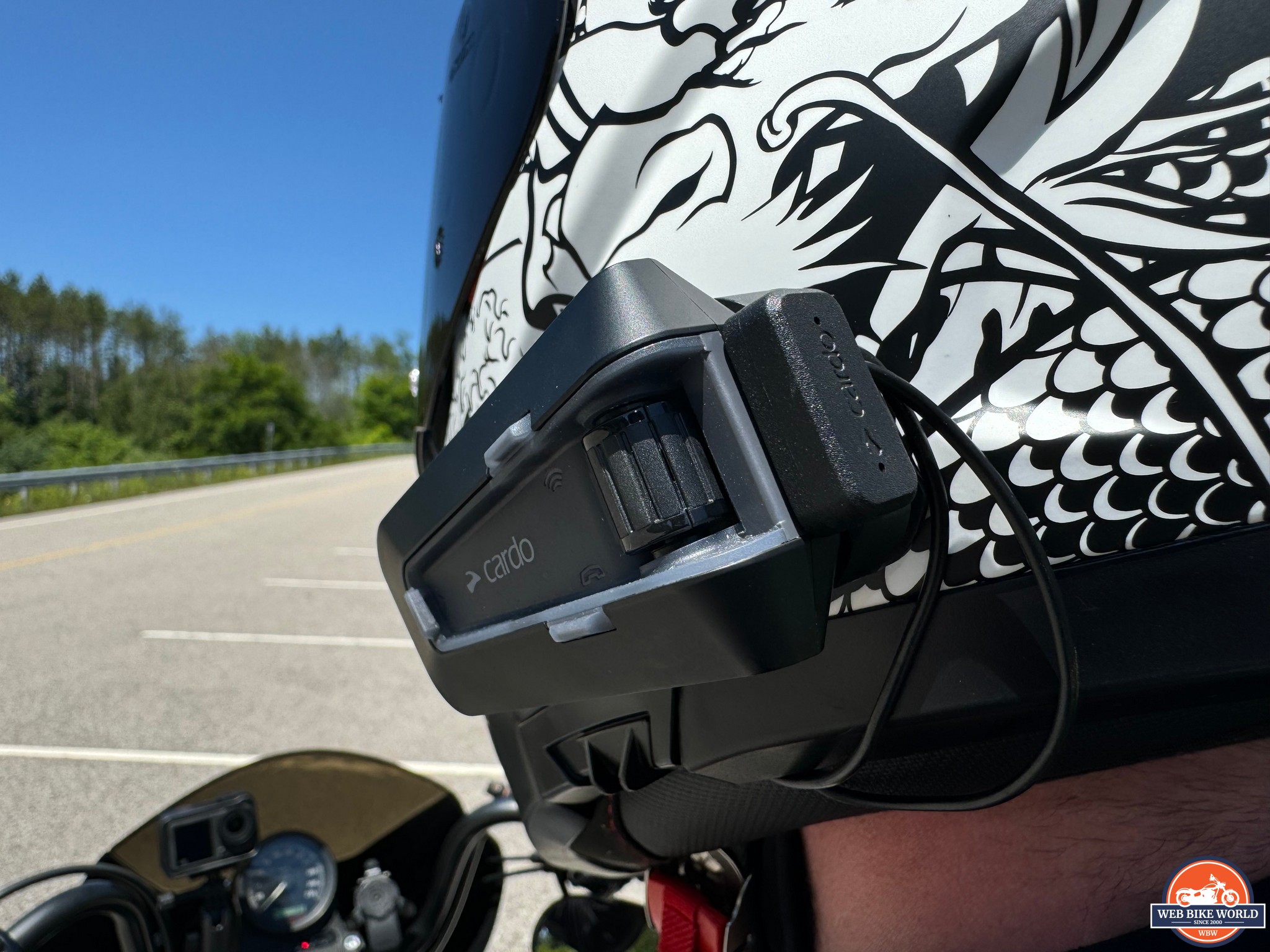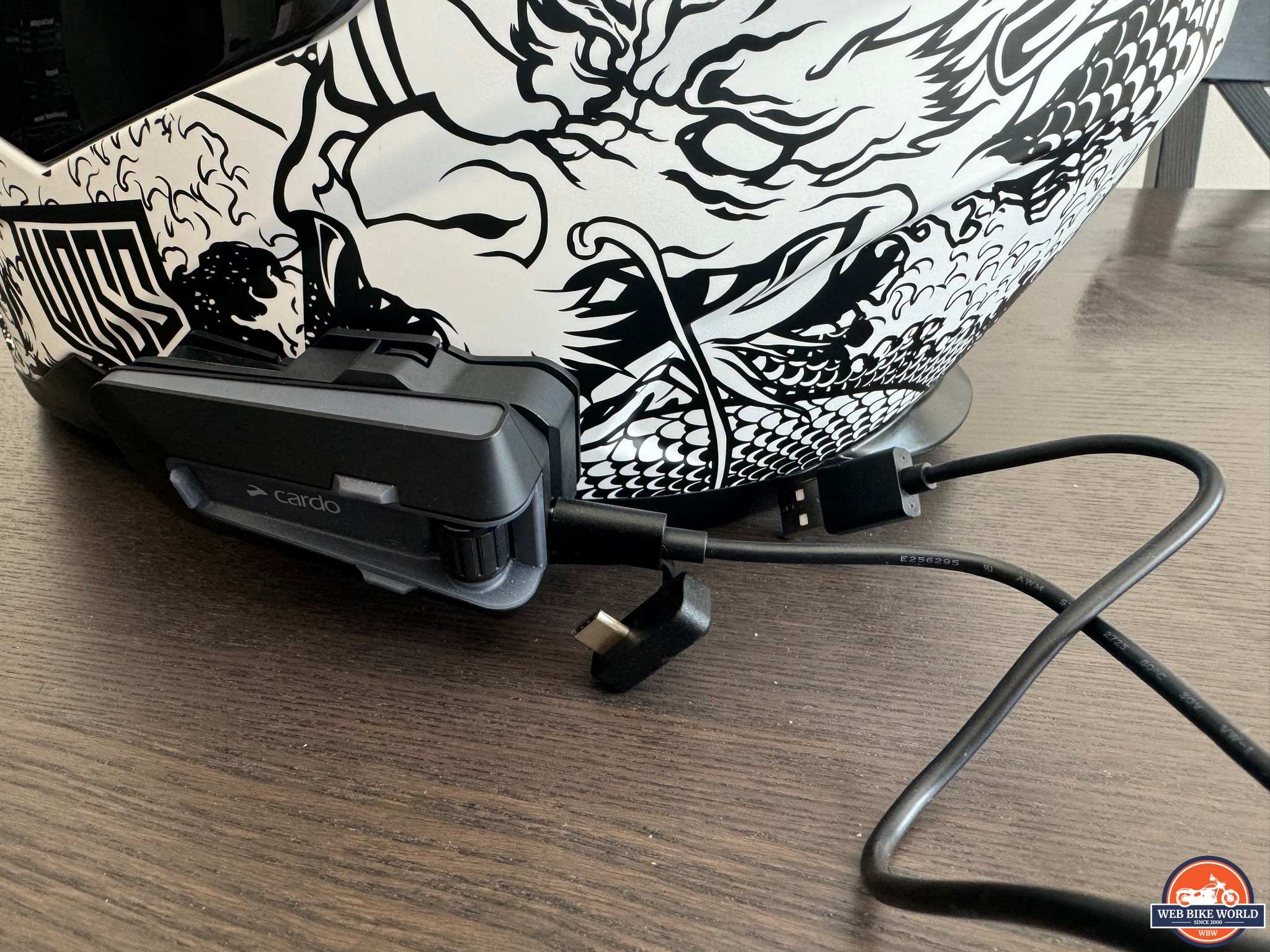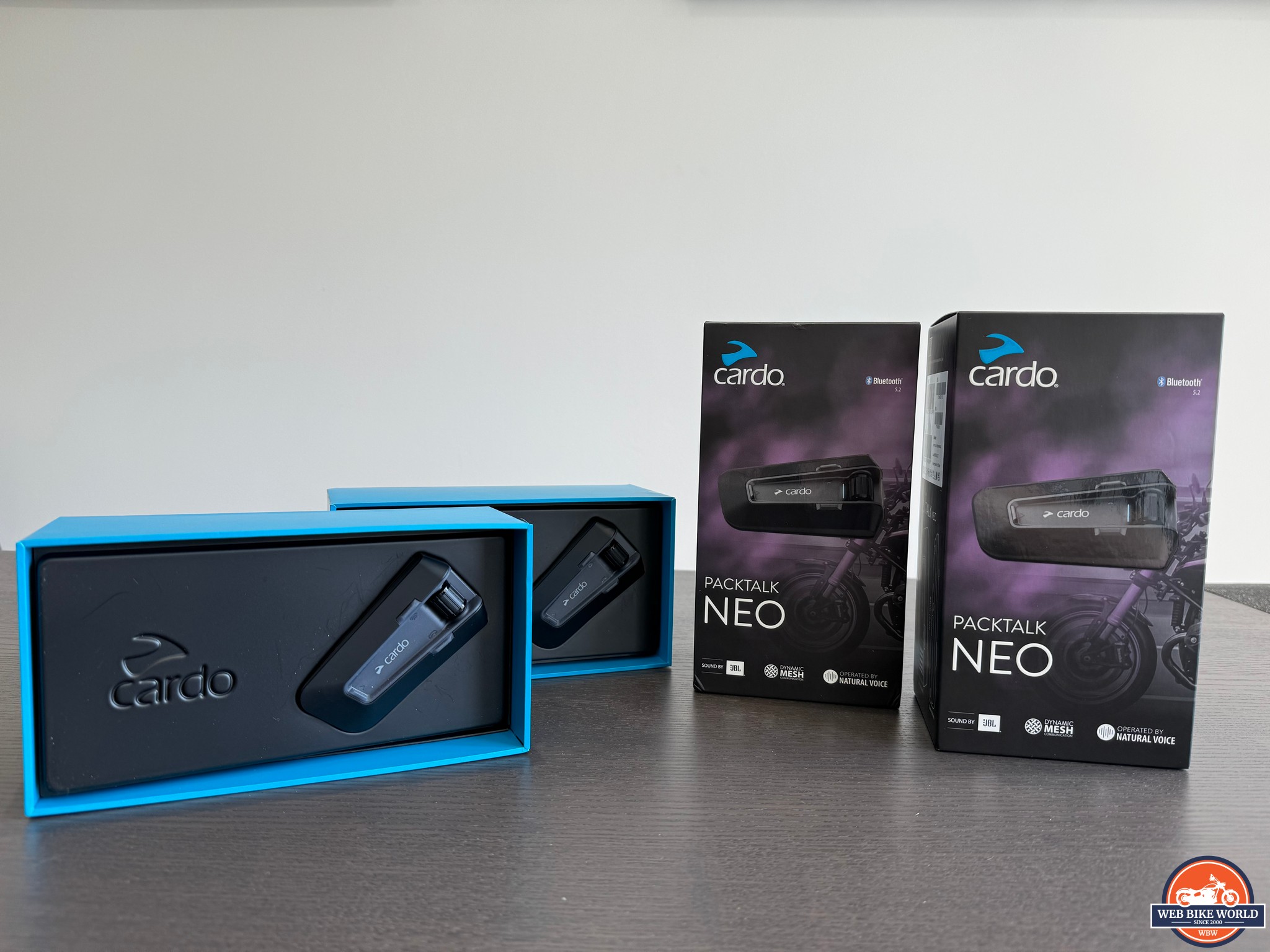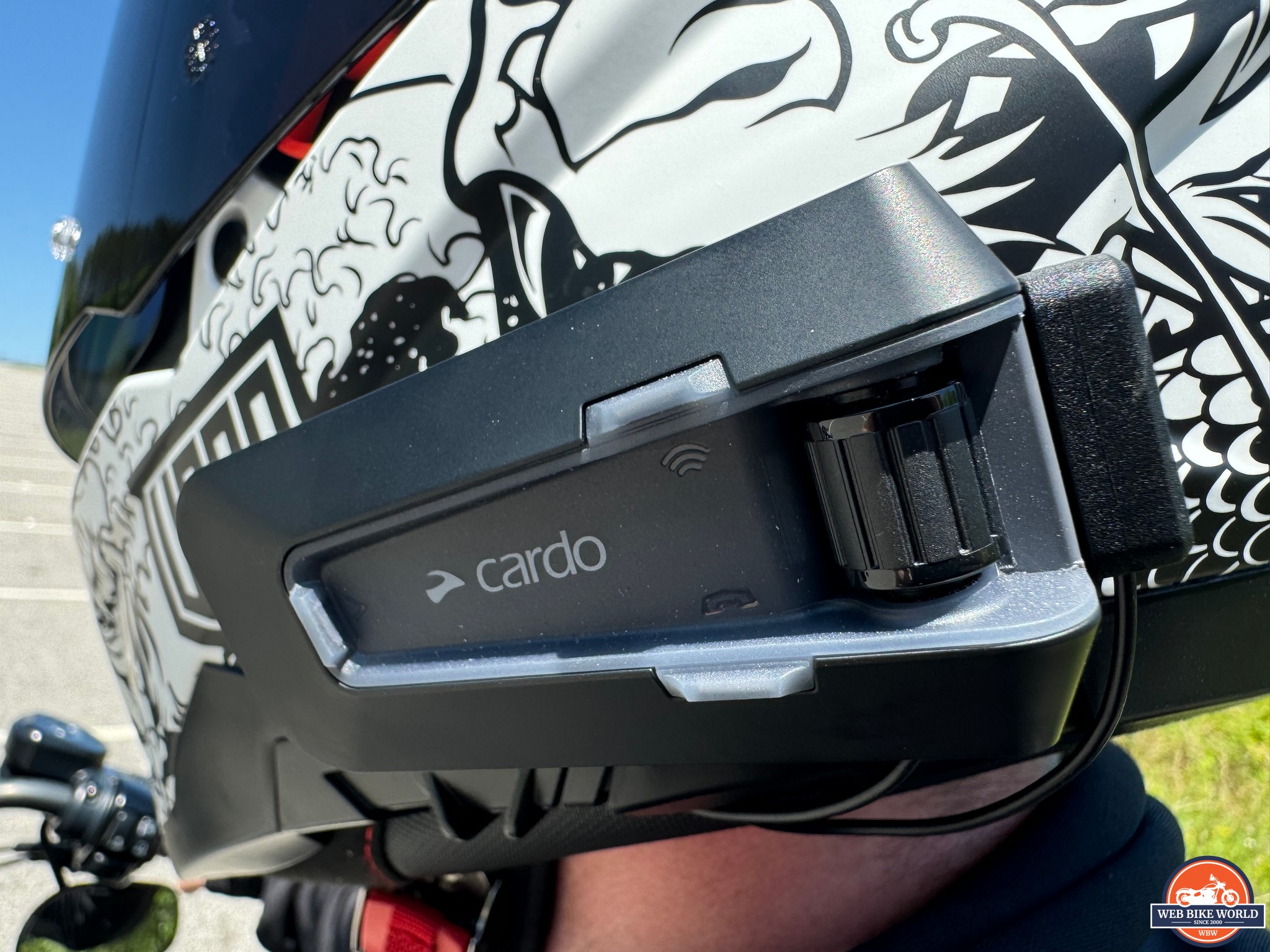Review Summary
If you’re looking for the main takeaways from this review, here is my summary of the Cardo Packtalk Neo:
- The Packtalk Neo offers the majority of the same great features as the Packtalk Edge but at a lower price point
- The unit is IP67-certified waterproof, is capable of cross-brand connectivity, and uses 40mm JBL speakers for premium sound
- The device has 3 main buttons that are fairly small and difficult to feel through a glove
- The Packtalk Neo mounts to the helmet via clips, as opposed to Cardo’s Air Mount as seen on their Edge units
- Speakers and microphone work flawlessly
- Natural voice operation allows you to control the device with voice commands
- Music and intercom can be used at the same time
- The app is easy to use but looks a bit rushed
- The Packtalk Neo can connect up to 15 riders and pairs effortlessly
- Battery life is approximately 13 hours under perfect conditions
- Overall the Packtalk Neo is a great value for those looking for large-group connectivity, especially when bought as a Duo
Cardo Packtalk Neo – A Step Above the Competition
Riding is cool, but riding in a group is even better. What beats that? Being able to communicate while you ride!
I don’t mean the occasional thumbs up at a red light, or trying to flag down the front runner because you need to pull over to piss.
No, I’m talking about actually communicating. You know, by using your mouth? After all, it’s the 21st century and hand signs have gone out of style.
Of course, you’ve heard of intercom systems. After all, you’re an avid reader of webBikeWorld and scrolled through our Intercom & GPS page, right? If not, don’t sweat it – I’ve got you covered.
Consider the hunt over. The Cardo Packtalk Neo is the only in-helmet system you need to consider, and I’m going to tell you why.
Wait, Who’s Cardo?
Most of you will scroll right past this because you haven’t been living under a rock.
For those of you who don’t know who Cardo is, I forgive you. They’re only one of the biggest names on the market when it comes to in-helmet Bluetooth headsets and speakers.
These guys have been around the block a few times since they started back in 2004. 20 years may not seem like a long time, but consider how far technology has come since! After all, 2004 was right around when Bluetooth really took off.
Cardo was the first to produce a motorcycle Bluetooth device. The technology came from cell phone earpieces they were producing at the time. With obvious success, the company grew from there, with the world’s first rider-to-rider headset in 2007, followed by the world’s first Dynamic Mesh communicator in 2015, with many other milestones in between.
Tech Specs
Let’s dive right into the juicy stuff.
On paper, the Packtalk Neo packs a punch.
- Intercom Technologies: Dynamic Mesh 2.0, Bluetooth, and Live Intercome
- Waterproof: IP67 Certified
- Unit-to-Unit Max Range: Up to 1.6KM / 1mi
- Group Intercom: 15
- Group Max Range: 8km
- Natural Voice Operation: Yes
- Sound Profiles: 3
- Bluetooth Version: 5.2
- Helmet Mount: Clickable
- Speakers: 40mm JBL
- Microphone: Hybrid & Corded
- Cross-Brand Connectivity: Yes
- Audio Sharing: Yes
- Intercom Recording: Yes
- Built-In FM Radio: Yes
- Battery: 13 Hours
- Charing While Riding: No
- Warranty: 2 years
- Over-the-Air Updates: Yes
A lot of that information is just Cardo bragging. Here are the key takeaways:
- 40mm JBL Speakers
- Cross-brand connectivity
- IP67 Certified
You may be wondering why I’ve isolated these 3 specs. The reason is simple – Cardo’s biggest competition does not offer them!
Sena vs Cardo
Sena and Cardo are like Coke and Pepsi. It’s a rivalry that’ll always exist with many riders who love Sena and many riders who love Cardo. Much like Coke vs. Pepsi, you’ll never be able to convince someone the other is better!
That’s why we look at the specs!
Sena uses Harman Kardon speakers for their units. In my experience, JBL speakers produce a clearer sound with deeper bass. However, please keep in mind that these findings are based on my trial of Ruroc’s Shockwave unit which are also Harman Kardon.
In regard to the speakers, a fellow reviewer, Jim Pruner, had similar findings when he reviewed the Cardo Packtalk Edge Communicator. You can read more about what he had to say here.
The Cardo unit being certified IP67 waterproof is another major difference. Sena claims their unit to be weather resistant. While I’m sure a bit of rain won’t hurt it, where do you draw the line? With Cardo, you have the peace of mind that it can withstand any weather.
The most important difference? Cardo units are compatible with any brand, while Sena units can only be linked to one another. This is an invaluable advantage that Cardo has over Sena. How often does everyone in a group have the same gear? There’s always that one person who has to be different. So next time you’re on a group ride and your buddy shows up with a Sena 50S, don’t worry. You can all stay connected, but no thanks to them!
Cardo devices connect up to 15 riders using their proprietary Dynamic Mesh Communication system. For those of you who want to learn more about how this system works, check out this blog post by Cardo here.
How Does the Packtalk Neo Perform?
On paper, the Packtalk Neo sounds like a hit, but how does it perform on the street? I’m going to break this category down into two basic categories:
- The sound quality of the unit
- The build quality of the unit
Each category will receive its own scoring as I believe both hold equal importance when considering a Bluetooth headset.
Build Quality of the Packtalk Neo
The first up is the build quality of the unit.
Straight out of the box, I could tell the Packtalk Neo isn’t some cheap, off-brand communicator. The unit has a soft-touch feel to it with seamless rounded ends, responsive buttons, and a smooth scrolling button on the back.
For the review, Cardo sent me two units. On their website, they list this as a Duo. By purchasing the Duo, there is a significant price break and you’ll receive two units, as well as all the necessary installation accessories.
The velcro patches used to mount the inner helmet speakers and microphone have a strong adhesive backing and hold exceptionally well. Even on the smooth material that lines my chin guard, the adhesive held strong and remained in place without issue.
The mounting bracket for the unit itself is flexible and durable. At first, I was hesitant that the small clips used to mount the Packtalk Neo to the helmet would hold, but it’s performed flawlessly so far. This is one of the main differences between the Neo & the Cardo’s top-of-the-line unit, the Edge.
The Edge uses a magnetic Air Mount to mount the unit onto the side of the helmet, while the Neo uses a clipping system. Truthfully, I didn’t feel like I was missing out on anything by not having the magnetic mount. It worked all the same for me! Not to mention, it installed effortlessly onto my Scorpion Covert FX helmet.
The Packtalk Neo has a total of four buttons on it – one in the front, top, bottom, and the aforementioned scrolling wheel in the back. While the wheel is simple enough to operate, the others are quite small and difficult to feel with a gloved finger.
Build Quality – 90%
My overall rating on the build quality of the Packtalk Neo is damn near perfect. The unit feels great in the hand, did not present me with any quality control concerns, and feels highly durable. I’m confident that the unit would be able to withstand a few hard impacts and still continue to perform the same as before. This is important to consider as the unit mounts outside of your helmet, and debris from the road can be unpredictable.
The only issue I have with the physical build of the unit is the three smaller buttons. I understand the desire to create a sleek and streamlined device, but I’d love to see bigger buttons for future releases! As we all know, gloves rarely fit perfectly and small buttons can be a huge nuisance to operate while wearing them.
Sound Quality of the Packtalk Neo – Speakers & Microphone
I’ve established that the unit feels great, but does it sound great? After all, what good is a Bluetooth intercom if you can’t hear what the other person is saying?
I’m pleased to say that when it comes to sound, the Packtalk Neo performed better than any other communicator I’ve used. In fact, this wasn’t just my opinion. Ashley, my passenger, made several comments about how well it performed compared to the Shockwave unit we had just recently trialed. You can read more about that here in my review of the Ruroc ATLAS 4.0 Carbon helmet.
Speaker Quality
The Packtalk Neo uses a JBL audio system and boy did it deliver! Even in my noisy Ruroc ATLAS 4.0 Street helmet, the bass from the speakers was crisp, deep, and extremely clear. At high speeds, sound quality would drop ever so slightly but that is to be expected on a motorcycle.
Included in the box are spacers that can be used to bring the in-helmet speakers closer to your ears. I didn’t feel the need to use them, but I installed them in Ashley’s helmet and she loved it. She claims that it helped drown out road/wind noise, and made the sound even clearer than before.
A big issue I’ve had in the past with intercom systems is having a hard time understanding what the other rider is saying. With the Packtalk Neo, this wasn’t an issue. While this was partly thanks to Cardo’s 2nd Generation DMC (more on that later), the speakers played a valuable role as well. Voices come through clearly and make conversations at high speeds effortless.
I was extremely pleased with being able to listen to music and chat at the same time. When music is playing, the unit will automatically lower the volume to allow for another rider’s voice to come through clearly.
Physically, the speakers feel high quality. They are prewired and plugged into the unit through a USB-C connection at the back. Installing them was effortless and took a matter of seconds once the helmet liner was off. All in all, the speakers were fantastic.
Microphone Quality
I can hear perfectly, but could others hear me?
Yes!
Two microphone options are included in the box. I chose to go with the smaller, thin-wire version as opposed to the larger flexible cord microphone. From a hardware standpoint, the microphone is excellent. It connects directly to the unit through the same USB-C connection as the speakers, and mounts inside your helmet on the chin guard.
On the software side, the Packtalk Neo has a few thoughtful features that make communicating effortless. For starters, the unit has natural voice operation capabilities. This means that you do not need to press a button before speaking. Simple talk and the unit will do the rest.
It also does a great job of filtering out all of the background noise, bike noise, wind noise, and breathing. Even in a larger group of riders, the sound of their bike would not be picked up by the microphone. This was a huge relief as I was concerned I’d hear an echo of my motorcycle through the unit when riding with Ashley as a passenger.
As was the case with other units, I didn’t have an issue with my breathing being picked up by the microphone. Unbeknownst to me in past experiences, I would be breathing heavily from the heat and that noise was being transmitted to whomever I was connected with. Thankfully, that wasn’t a concern with the Packtalk Neo.
On the phone, the unit performed the same. I was surprised as sometimes on the software side of things the units perform differently between intercom and phone calls. A lot of the time, the receiver wasn’t able to tell I was on my motorcycle. To them, it sounded like any other Bluetooth call.
Sound Quality – 100%
I was thoroughly impressed with the sound quality of the Packtalk Neo. The unit sounds amazing right out of the box and can be customized further to your liking through the app (more on that later). Communication through the intercom and/or phone calls was effortless and easy to understand
The microphone is sensitive enough to pick up your voice through environmental background noises, all the while refraining from transmitting those same sounds through the intercom.
If desired, Cardo even offers a larger 45mm JBL speaker kit on their website for riders who want to further improve their audio experience. I felt like the 40mm speakers were powerful enough, but some of you with a louder bike/helmet may want to consider upgrading.
For once, I don’t have anything negative to say. The sound quality was exceptional and alone is enough for me to recommend this unit to others.
Using the Packtalk Neo
Using the Packtalk Neo could not be any easier. This little device is full of neat features, some of which I’m sure I haven’t even discovered. In terms of ease of use, Cardo has knocked it out of the park. In order for you to get a true sense of what it’s like using the Packtalk Neo, I’ll start with the basics and move up from there.
Basic Operation
As previously mentioned, the Packtalk Neo has three buttons and a clickable control wheel. These rolls of these buttons are divided into media (left), mobile (bottom), and intercom (top). The wheel is used to control the unit volume, as well as start/stop music.
Once paired, the unit will automatically connect to your mobile device upon start-up. This was highly convenient for me as I typically turn on my device after gearing up. Not having to remove my gloves and fiddle with my phone was super handy.
Voice Control
I don’t know about you, but the last thing I want to do is fiddle around with my Packtalk Neo while riding and trying to remember what button does each command. It’s almost like the developers at Cardo felt the same way, hence the implementation of voice control.
Much like your smartphone, the device can be controlled by a simple Hey Cardo, followed by the command. You can use the voice assistant for almost every command, such as muting your mic, answering/ignoring calls, adjusting the volume, and more.
You can also use your smartphone’s voice assistant through the Cardo. Simply speak the phrase that wakes your device, and give it a command. In my case, Siri took a back seat while I let the Packtalk Neo do all the work.
There was only one instance where the device misheard what I said and entered a loop that echoed my voice endlessly. Simply turning the device off and on corrected it. Perhaps this is something Cardo can look into and fix through a software update?
Cardo Connect
Before you can actually use the Packtalk Neo, you’ll need to download the Cardo Connect app. This is the smart functions of the device that’ll allow you to make use of the intercom, Bluetooth, and more. It’s also where you will pair with other units for a group ride.
The app is simple to use and very straightforward. After answering a few basic questions, your profile will be set up and you’re ready to go. With the device paired, the app’s interface will change into the main screen.
With large buttons for easy operation, while wearing a glove, you can navigate to your phone, intercom, music, and radio from the phone screen. You can also record your voice, which is a super handy feature for those of you who may want to vlog/create content while riding.
A little gear icon on the top left of the main screen opens up the settings menu. From here, you can customize your audio settings, change the units, display, and more. In the audio settings is a neat feature called Automatic Volume.
Essentially what this does is raise and lower the sound output depending on the environmental noises. This means while riding at lower speeds, your music will automatically get louder so that you can hear, and then lower itself again when stopped at a red.
While this isn’t groundbreaking technology and has been around for a while, it’s another feature of the Packtalk Neo that contributes to the overall convenience theme I’ve been trying to convey.
Intercom Pairing Through Cardo Connect
When they said easy pairing, they meant it.
Inside the Cardo Connect app is an option for Intercom. From here, you can operate the Packtalk Neo’s DMC features, as well as the Bluetooth intercom. Starting, leaving, and joining a group is as easy as a tap of a button. Simply name the group, pair, and talk away!
The app will save your group session for future use and automatically rejoin that group upon start-up if you did not leave it before powering off.
Ease of Use – 85%
Cardo’s natural voice operation is the real star of the show when it comes to how easy it is to use the Packtalk Neo. As I previously mentioned, the buttons can be difficult to operate in a gloved hand but having the option to control the device through voice helps mitigate that problem.
While the app is easy to use, it could use a facelift. In my opinion, it looks a bit thrown together without much thought put into the aesthetics of it. Of course, this doesn’t affect the performance of the app but I’d love to see something a bit more pleasing considering the Packtalk’s are known as a premium device.
Battery Life
The Packtalk Neo has an impressive battery life with up to 13 hours of usage on a single charge. While this lifespan is highly dependent on numerous factors, I struggled to drain the battery in any given week.
Upon start-up and shut down the Packtalk Neo will give you the approximate battery life. This made it simple to keep a mental track of when it was time to charge. You can also find the battery life of the unit inside the app so that you can keep an eye on it during use.
The Packtalk Neo makes use of a USB-C port to charge it. Unfortunately, the same port is used for the speakers and microphone input, so the device needs to be disconnected before charging. If you find yourself with a dead unit, 20 minutes of fast charging will get you approximately 2 hours of talk time.
Battery Life Rating – 90%
So far the battery life of the Packtalk Neo has performed wonderfully. You’re able to use the device for long periods of time off of one charge and can quickly fast-charge it when needed.
As is the case with all tech, there is always room for improvements when it comes to battery life. Hopefully, with future releases, we will see longer battery life on the Packtalk units, but for now, the 13 hours of talk time is more than sufficient.
In addition, I’d love to see a separate port for the charger. While disconnecting the unit isn’t a big deal, it would be highly convenient to be able to charge the Packtalk Neo without removing any existing cables.
Is the Packtalk Neo Worth the Price Point?
Here’s where things get tricky – deciding whether or not the Cardo Packtalk Neo is worth its price point. While I can provide you with my opinion, the answer to this question is highly user-dependent!
For example, how will you primarily be using the device? Are you purchasing a Packtalk Neo to listen to music while you ride, or do you want to take advantage of its group riding capabilities?
If your answer is the former, you may be better suited with something like the Cardo Freecom 4X Communicator which will still sound great, but is at a much cheaper price point as communication is limited to 4 people.
For the latter, the Packtalk Neo is an exceptional choice for you. As I’ve covered, the device has almost all of the great features of the Packtalk Edge, but at a discounted rate. The price is even more competitive when bought as a Duo.
Value for Money – 85%
Let’s make no mistake, the Packtalk Neo is not cheap, but for those who are in the market for crisp sound, group riding capabilities, cross-brand connectivity, and more – this is the device for you.
I can’t give it a perfect score because let’s face it, we’d all love to see a cheaper price. For those looking to maximize savings, hold out for a sale or go halves with a friend on the duo pack!
Final Verdict
If you couldn’t already tell, I’m a huge fan of the Packtalk Neo.
Everything from how easy it is to operate the device to the amazing sound at high speeds – I was highly impressed.
In-helmet communicators can be hit or miss! I’ve had my fair share of experiences with hard-to-hear intercoms, choppy connectivity, and tinny speakers that sound like cans of tuna.
With the Packtalk Neo, a lot of my complaints are minor and would be overlooked by the average user. If it wasn’t my job to bring you the ins and outs of the device, I would likely have overlooked them as well!
While cheaper options exist on the market, you’re sacrificing performance and device capabilities. Even if you don’t plan on riding in a group, if I could make a recommendation to you, it would be to grab the Packtalk Neo and prevent having to upgrade to a future device in the future! You never know where the road might take you – you might just find yourself riding with friends you haven’t yet met!
Pros
- Natural voice operation allows you to control the unit hands-free
- Very clear voice output
- Amazing sound even at high speeds
- Long battery life
- Easy grouping with 2nd Generation Dynamic MESH Communication, including units from other brands
- Easy-to-use app
- Secure mount that is discreet
Cons
- Small buttons make it hard to operate the unit while riding
- The initial connection can be finicky
- The app could use a makeover to be more visually pleasing
- 1 USB-C port shared between the audio input & charger
- Minor software bug fixes to hands-free voice operation are required
Specifications
- Manufacturer: Cardo Systems
- Price: $319.95
- Review Period: May 2024 – July 2024


